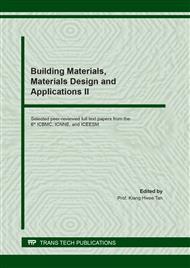p.3
p.13
p.21
p.29
p.39
p.45
p.53
p.61
The Tensile and Flexural Forces of Acropora Reef Waste Particulate-Enchanced Polyester Composites
Abstract:
Composite is a material that combines two or more materials that basically dissimilar chemical or physical properties from one another. In this research, we used Acropora coral reef waste particulate and Resin Polyester BQTN type 157 with Methyl ethyl ketone peroxide (MEKP) 1% as the hardener. The Hand Lay-Up molding technique is used in the process of making the material. The tensile and flexure test is done according to the ASTM D3090 and ASTM D790 – 03 standards. The purpose of this research is to discover the means to produce a composite enhanced by Acropora coral reef waste with polyester matrix and to learn the tensile and flexure strength from the Acropora coral reef waste particulate-enhanced polyester composites with mass fraction varieties of 10%, 20%, 30%, and 40%. The tensile test result of Acroporal coral reef waste particulate with polyester matrix yields average tensile strength at mass fraction variety of 40% with a score of 19,66 MPa, with an Modulus score of 636,75 MPa. The flexure test result of Acropora coral reef waste particulate with polyester matrix yields average flexure stress at mass fraction variety of 40% with a score of 112,56 MPa, with an average Elastic Modulus score of 3098,96 MPa.
Info:
Periodical:
Pages:
21-27
Citation:
Online since:
August 2021
Keywords:
Price:
Сopyright:
© 2021 Trans Tech Publications Ltd. All Rights Reserved
Share:
Citation:


